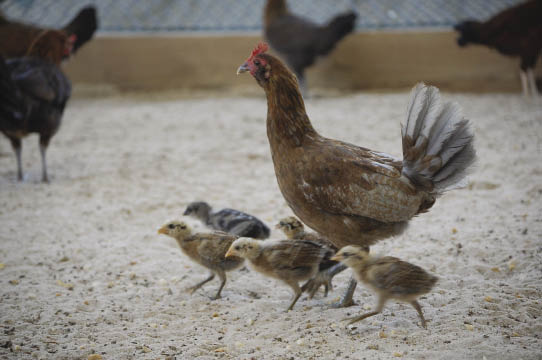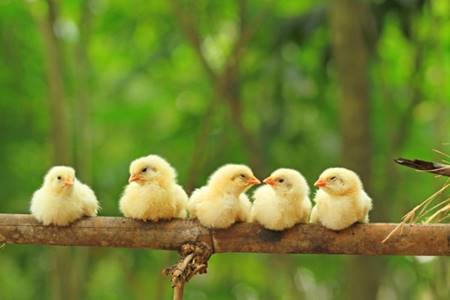Birth of a Baby Chicken: An Easter Story
By Karen Davis, PhD, President of United Poultry Concerns
INSIDE THE EGG

Chick embryo on the 9th day of incubation.
If the egg has been fertilized, a tiny being is growing inside, whether nestled beneath the mother hen or crammed in an incubator among thousands of other embryos. During the first 24 hours after the egg is laid, the tiny heart starts beating and blood vessels begin to form, joining the embryo and the yoke sac that will nourish the embryo as it grows.
The nervous system originates during the 21st hour of incubation, followed by origination of the head and eyes. Other body parts begin to develop during this time, including the alimentary tract and the spinal column. On the third day, the embryo begins to rotate to lie on its left side. By the fourth day, all body organs are present, with the nose, legs, wings, and tongue taking shape and the vascular system in place.
On the fifth day, the reproductive organs differentiate and the face begins to assume a lifelike appearance. On the sixth day, the beak and the egg tooth (a kind of rough edge that disappears after hatching, which protects the beak and also helps crack the shell) can be seen, along with some voluntary movements of the embryo.
During the next seven days, the body develops rapidly, including the formation of the abdomen and intestines. Feather germs, the origin of feather tracts, appear, the beak begins to harden, toes and leg scales start to show, the skeleton begins to calcify, and chick down appears.
On the fourteenth day, the embryo, now covered with down, rotates to arrange itself parallel to the long axis of the egg, normally with its head toward the large end of the egg near the air cell. On the seventeenth day, the chick turns its head, placing its beak under its right wing toward the lower part of the enlarged air cell to prepare for hatching and breathing outside the shell.
HATCHING
On the nineteenth day, the yoke sac begins to enter the chick’s body through the umbilicus, and the chick positions itself for pipping the shell, that is, for making a hole in the shell to breathe through while struggling to get out. On the twentieth day, the yolk sac completes it absorption into the body cavity and the umbilicus begins to close. By now, the chick occupies the entire area within the shell except the air cell, which it now begins to penetrate with its beak, inhaling outside air through its lungs for the first time.
After pipping the shell to reach the air cell, the chick rests for several hours. It then cuts a circular line counterclockwise around the shell by striking the shell with its egg tooth near the large end of the egg, aided by a special pipping muscle in its neck which helps it to force its beak through the membranes lining the shell.
With the egg tooth, the chick saws its way out of the shell, aided by the mother hen if she is there and help is needed. Between 10 and 20 hours after the shell is first broken, the chick emerges, wet and exhausted, to face the life ahead.

A newborn chick is exhausted following hours of hatching from its egg.
Nearly two days may pass between the hatching of the first chick and the appearance of the last member of the brood. Thus, some chicks may be almost two days old by the time all of their sisters and brothers have struggled from their shells, as many as 16 others. However, hatching is not a haphazard process.
About 24 hours before the chick is ready to hatch, it starts peeping in its shell to notify its mother and siblings that it is ready to emerge. A communication network is established among the chicks, and between the chicks and their mother, who must stay composed while all the peeping, sawing, and egg-breaking goes on underneath her. Since some eggs may be infertile or aborted, the peeps tell the hen how long she needs to continue sitting on the nest.
MOTHER HEN AND HER CHICKS

Mother hen on the move with her eager chicks. Photo by Davida G. Breier
As soon as all the eggs are hatched, the hungry mother and her brood go forth eagerly to eat, drink, scratch the soil, and explore. Baby chicks are precocial, meaning they are genetically equipped to find food and follow their own kind, or whoever is in charge, in the process known as imprinting. By imprinting, chicks learn the features of their mother hen and siblings, to insure their survival. They practice hygiene by preening their feathers and dustbathing almost immediately.
The chicks venture fairly far away from their mother, communicating back and forth all the while with clucks and peeps. The hen keeps track of her little ones on the basis of color, possibly also by smell, and by counting the peeps of each chick and noting the emotional tones of their voices. Periodically she squats down, and the chicks dash under her outspread feathers where they stay until they are thoroughly warmed before dashing out again.

Mother hen warms and protects her chicks. Photo by Davida G. Breier
Should a peep be missing or sound frightened, she runs to find the chick and deliver it – not always successfully – from the hole in the ground, tangled foliage, or threatening predator.
During the first four to eight weeks or so, the chicks stay close to their mother, gathering beneath her wings every night at dusk. Eventually, she flies up to her perch, indicating her sense that they, and she, are ready for independence.
Young chicks without their mother huddle together at night for the first month or two. Then one evening, you see them practicing sitting in a row, before huddling. Then comes an evening when they are lined up on their perch, arranging and rearranging themselves as before, only this time they stay lined up all night, henceforth roosting like the adults.

Chicks without their mother learn to perch in a row like the grown-ups.
KAREN DAVIS, PhD is the President and Founder of United Poultry Concerns, a nonprofit organization that promotes the compassionate and respectful treatment of domestic fowl including a sanctuary for chickens in Virginia. Inducted into the National Animal Rights Hall of Fame for Outstanding Contributions to Animal Liberation, Karen is the author of numerous books, essays, articles and campaigns. Her latest book is For the Birds: From Exploitation to Liberation: Essays on Chickens, Turkeys, and Other Domesticated Fowl (Lantern Books, 2019).
Amazon Reviews Praise
FOR THE BIRDS: FROM EXPLOITATION TO LIBERATION
by Karen Davis, PhD.
| Order Now! |
Don't just switch from beef to chicken. Go Vegan.
www.UPC-online.org


